Order Araneae
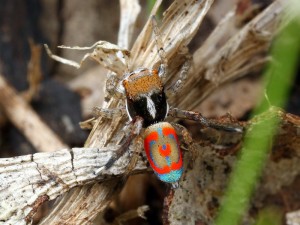
spider. The males of this genus are renowned
for their bright colours and dazzling
mating displays.
Arachnophobia is probably one of the most common fears in the world and the mere thought of a spider can send some people into uncontrollable hysterics. I suppose some of this fear could be justified when you consider the fact that some Australian spiders can be lethal, but if you can convince yourself to look beyond this, you will find that spiders can be beautiful (yes, I did use that word), intelligent, and absolute masters in the use of silk.
Spiders have two main body sections – the cephalothorax and the abdomen. Insects have three sections – head, thorax and abdomen. The cephalothorax is basically a head and thorax that have been fused together to form one unit. All spiders have eight legs – four legs on each side of the cephalothorax. They have four, six or eight simple eyes (not compound eyes like insects) arranged in varying patterns, although in some species the eyes are absent altogether.
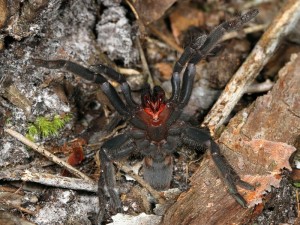
showing me her large, blood-red fangs.
At the front of the cephalothorax are two projections called chelicerae, which hold the fangs used for piercing prey and injecting venom. They also have a pair of pedipalps, which are the spider equivalent of insect antennae. Pedipalps are used for sensing objects, aiding in web building and the capture of prey, and in the case of males, transferring sperm to the female during mating.
The abdomen contains the digestive system and two or three pairs of spinnerets. The spinnerets are located at or near the end of the abdomen and are used for spinning silk, which can be used for constructing prey-catching webs, retreats, or egg sacs. Silk is a truly amazing natural innovation: a single strand can be five times stronger than steel of the same width, whilst being able to stretch to twice its length. With the addition of some naturally produced glue, it becomes a highly effective tool for catching a meal.
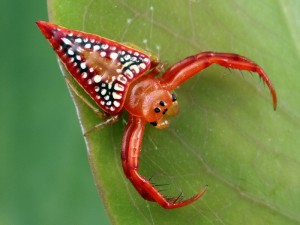
that waits for its prey to get close enough to
grasp it with its heavily-spined legs.
Spiders are predators that feed on insects, other spiders, and sometimes small reptiles and amphibians. Many species use silk webs to ensnare their prey, while others are active hunters or ambush predators. Once caught, the prey is quickly killed by the toxic venom injected through the spider’s fangs. Special saliva is then used to liquify the victim’s body tissue, which is then sucked out, leaving an empty shell that the spider discards.
Reproduction is a swift and usually deadly affair. Male spiders risk their lives for the chance to mate and if they give off the wrong signal, they will find themselves on the menu very quickly. Even if they do manage to seduce the female, there is still only a 50-50 chance they will escape to tell about it. And if they do manage to survive the experience, the energy expended usually results in their demise soon after because they generally don’t feed during the pursuit of a mate.
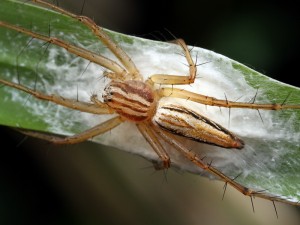
her clutch of silk-covered eggs.
Female spiders lay eggs, which can number just a handful or hundreds, and they protect them by wrapping them in a weather-proof, predator-resistant, silk casing. In a lot of cases, the females will guard the egg sac until the spiderlings hatch. Sometimes, as in the case of wolf spiders for example, they will continue to carry their young with them for a short time after hatching. The spiderlings reach sexual maturity over a period of six months to four years through a series of moultings. Most spiders only live for up to a year, but some species can live for as long as 20-25 years.
Spiders can be found in a wide variety of habitats in Australia, most species occurring in forested areas with mild to warm year-round climates. Some have adapted to semi-aquatic lifestyles, while others survive very well in desert conditions.
Of the approximately 10,000 known species in Australia, only about 2,500 have been described, which shows just how much is still to be learned about these fascinating creatures.
~~~~~
Click here to see the Spider photo galleries
~~~~~
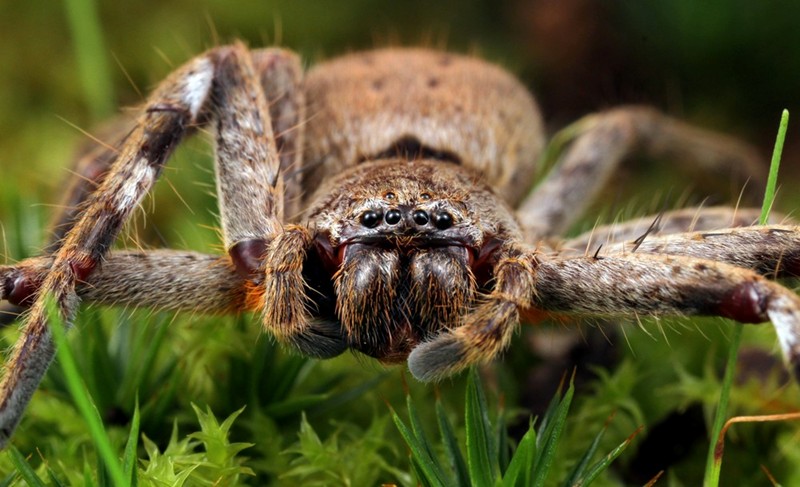
I would like to take this opportunity to sincerely thank my friend, Ron Atkinson, formerly of the University of Southern Queensland, for his invaluable assistance in helping me identify many of the spiders in my photos. For more in-depth information on Southern Queensland spiders and their venom toxicity, please visit Ron’s spider site by clicking on this link: Find-a-Spider
Also special thanks to Dr. Robert Raven of the Queensland Museum for his generous assistance with new identifications and corrections to existing identifications. The “unknown” list just got a whole lot smaller! Thanks Dr. Raven.
And thanks to Robert Whyte and Dr. Greg Anderson from Arachne.org.au for their assistance with several identifications, especially the jumping spiders.